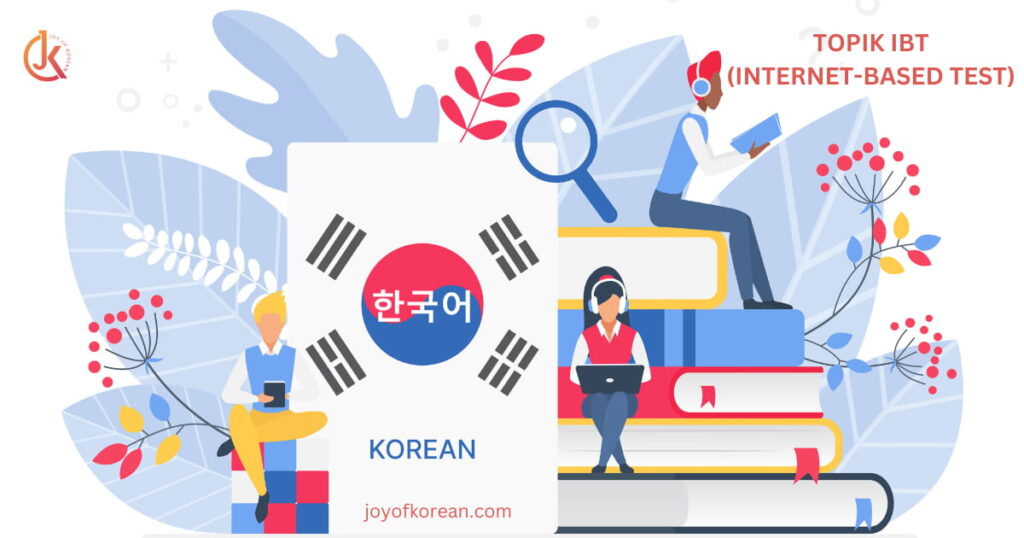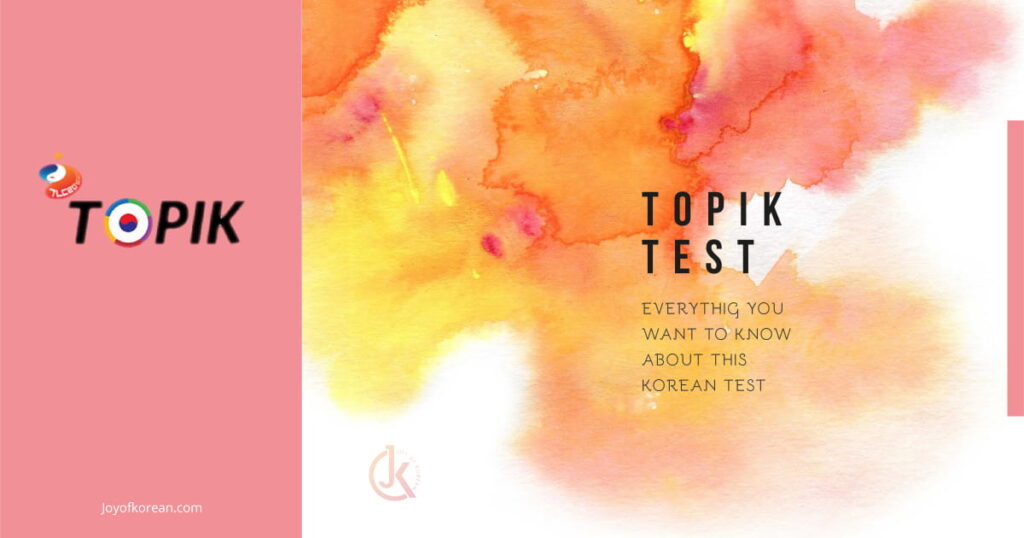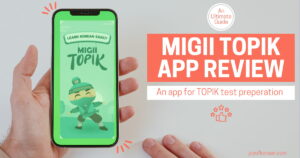Test of Proficiency in Korean comes in many flavors. In contrast to standard TOPIK and speaking tests, the TOPIK IBT (Internet-Based Test) is a new-age computer-based exam.
Learning Korean is rewarding for several reasons. Many motivations exist, from studying in South Korea to scholarships and jobs requiring Koreans to have hobbies.
If you aim to measure your Korean language skills, you may know about the TOPIK test. But are you aware of TOPIK IBT (Internet-Based Test)?
This international Korean proficiency test serves many purposes and certifies the Korean language skills of non-native speakers.
Let’s find out everything about the TOPIK IBT (Internet-Based Test). This 2025 guide includes registration, benefits, schedule, test structure, format, fee, and more.
Table of Contents
- What is TOPIK IBT (Internet-Based Test)?
- What are the advantages of TOPIK IBT?
- All About TOPIK IBT (Internet-Based Test)
- Conclusion: Should you take this test?
What is TOPIK IBT (Internet-Based Test)?
The Test of Proficiency in Korean (TOPIK) has a modern computer-based version: TOPIK IBT. It checks the Korean language ability of non-natives for various goals, such as academic, immigration, and professional.
Like other TOPIK types, NIIED (National Institute for International Education) administers IBT on behalf of the South Korean government.
The TOPIK IBT is a convenient and easily accessible Internet-based test for global Korean learners.
This official test, with the same validity and grading system as the TOPIK Paper-based test, offers a more flexible testing experience.
What are the advantages of TOPIK IBT?
There are many apparent benefits of TOPIK IBT.
You can study undergraduate, postgraduate, doctorate, or professional courses in South Korea. It also boosts your chances of applying for GKS (Global Korean Scholarships).
IBT helps you pursue Korean-language careers. You can apply to various public institutions and private companies in your home country, Korea, and abroad. Besides, you can get a visa and work permit for jobs in South Korea and qualify for permanent residency, jobs, projects, etc.
The Internet-Based Test lets candidates take the exam from home or anywhere with Internet access.
This flexibility is an immense advantage over traditional testing methods. This makes it easier for people with difficulty traveling to test centers or scheduling conflicts.
IBT assesses listening, reading, writing, and speaking skills. This provides a complete assessment of the test-taker’s skills. Students can use this digital format to show their talents and learn to use online platforms, a must in today’s digital world.
Digital scoring produces faster results. It is simple for tech-savvy candidates who are comfortable with computer-based tests.
All About TOPIK IBT (Internet-Based Test)
The online TOPIK is crucial to anyone serious about learning Korean. Let’s uncover all the details.

1. How to take the test and eligibility criteria?
The TOPIK IBT test works like the traditional TOPIK PBT test, with the same usefulness and grading system.
Non-native Korean speakers, such as students, professionals, and individuals, can take the test. You also need a proper ID card for identity verification.
On the test day, you’ll go to your designated test center, where you’ll take the exam on a computer or tablet ready for you.
The online exam is more flexible than the paper version. You can take it when it’s suitable for you. Test takers use a computer to respond to questions and finish sections like writing and listening.
2. What is the validity?
IBT, like the standard test, remains valid for two years following the release of the exam scores.
3. Results
Test-takers can view their test results and score reports within 4 to 5 weeks after the exam date.
4. Grading and Levels
There are two levels: TOPIK I (basic) and TOPIK II (intermediate to advanced). It focuses on four areas: reading, writing, listening, and sometimes speaking (if opted).
| TOPIK Type | levels | Overall Score |
|---|---|---|
| TOPIK IBT I | Level 1 | 132 – 207 |
| Level 2 | 208 – 400 | |
| TOPIK IBT II | Level 3 | 204 – 261 |
| Level 4 | 262 – 330 | |
| Level 5 | 331 – 411 | |
| Level 6 | 412 – 600 |
The TOPIK level you achieve depends on your total score. The total score for the TOPIK I test is 400 points, and for TOPIK II, it is 600.
5. Test structure
The TOPIK IBT differs slightly from the paper test, having fewer questions and a shorter time limit.
| Test Types | Section | Question Type | Number of Questions | Score | Total Score |
|---|---|---|---|---|---|
| TOPIK Ⅰ (Level 1-2) | Listening (40 mins) | Multiple Choice | 30 | 200 | 400 |
| Reading (45 mins) | 30 | 200 | |||
| TOPIK II (Level 3-6) | Listening (45 mins) | 40 | 200 | 600 | |
| Reading (55 mins) | 40 | 200 | |||
| Writing (50 mins) | Writing | 3 | 200 |
TOPIK Speaking for IBT
TOPIK Speaking occurs on the same day as the end of TOPIK II IBT. It is independent and optional for candidates.
| Question | Type | Preparation Time | Response Time |
|---|---|---|---|
| 1. | Listen to the simple question and answer it. | 20 seconds | 30 seconds |
| 2. | Use familiar social situations to ask and answer. | 20 seconds | 40 seconds |
| 3. | Create a story using different scenes. | 40 seconds | 60 seconds |
| 4. | Listen to a dialogue and respond to the question. | 40 seconds | 60 seconds |
| 5. | Provide an explanation and critical analysis of the content. | 70 seconds | 80 seconds |
| 6. | Share your opinions on the topic. | 70 seconds | 80 seconds |
| Evaluation factor | Description |
|---|---|
| Content and task performance | Does the candidate express themselves appropriately about the topic? Has the performance and flow been organized and coherent? |
| Command of the language | Is the language appropriately used in the dialogue’s context? Have they used a variety of vocabulary and expressions? And how correct was it? |
| Pronunciation and delivery | Is their speech easy to understand (good pronunciation and intonation)? Did they speak at a natural pace? |
| Fail | Sublevel 1 | Sublevel 2 | Sublevel 3 | Sublevel 4 | Sublevel 5 | Sublevel 6 | |
|---|---|---|---|---|---|---|---|
| Score | 0 – 19 | 20 – 49 | 50- 89 | 90 – 109 | 110 – 129 | 130 – 159 | 160 – 200 |
| Level and Score | Level Description |
|---|---|
| Level 1 (20 – 49) | a) Can ask and answer questions about everyday activities in a familiar setting, which is often incorrect. c) Pronunciation, intonation, and difficulty in expressing themselves clearly. |
| Level 2 (50 – 89) | a) They can share their thoughts on familiar social issues in detail. b) While they sometimes make mistakes, they can use some vocabulary and phrases that generally match the conversation. c) Their pronunciation, intonation, and pace might sometimes sound a bit off, but they express themselves comfortably! |
| Level 3 (90 – 109) | a) They can share their thoughts on familiar social issues in detail. b) While they sometimes make mistakes, they can use some vocabulary and phrases that generally match the conversation. c) Their pronunciation, intonation, and pace might sometimes sound slightly off, but they express themselves comfortably! |
| Level 4 (110 – 129) | a) To logically and persuasively express their thoughts on social issues or abstract concepts. b) Makes almost no mistakes and can use a wide range of vocabulary and grammar in various discourse contexts. c) Pronunciation, intonation, and pace are natural, and their delivery is excellent. |
| Level 5 (130 – 159) | a) The individual demonstrates the ability to articulate their views on various social issues in a detailed and coherent manner. b) While occasionally making errors, they possess a diverse vocabulary and utilize expressions generally appropriate for the discourse context. c) Although their pronunciation, intonation, and pacing may be unnatural, they can generally convey their thoughts effectively. |
| Level 6 (160 – 200) | a) Individuals can articulate their thoughts on social issues and abstract concepts logically and consistently. b) While they may make some mistakes, they demonstrate the ability to use a diverse vocabulary and expressions that suit the context of the discussion. c) Their pronunciation, intonation, and pacing are generally natural, and their delivery is effective. |
5. TOPIK IBT Schedule 2025
They will conduct the 5th, 6th, 7th, 8th, 9th, and 10th one in 2025. While you can take the test up to six times, the TOPIK schedule this year may vary depending on your region and the time differences.
| Exam | Registration Period | Test Dates | Result Dates | Location |
|---|---|---|---|---|
| 5th TOPIK IBT | Dec 17-23, 2024 | Feb 22, 2025 | Mar 14, 2025 | Globally |
| 6th TOPIK IBT | Jan 14-20, 2025 | Mar 22, 2025 | Apr 11, 2025 | Globally |
| 7th TOPIK IBT | Apr 15-21, 2025 | Jun 14, 2025 | Jul 4, 2025 | Globally |
| 8th TOPIK IBT | Jul 15-21, 2025 | Sep 13, 2025 | Oct 2, 2025 | Globally |
| 9th TOPIK IBT | Aug 26-Sep 1, 2025 | Oct 25, 2025 | Nov 14, 2025 | Globally |
| 10th TOPIK IBT | Sep 23-29, 2025 | Nov 29, 2025 | Dec 19, 2025 | Globally |
6. Test Centers in 2025
As of 2025, there are 80 authorized test centers for TOPIK-IBT worldwide.
Of all, 49 centers are in South Korea, and 31 are in 15 other countries mentioned below.
- Asia (China, Japan, Uzbekistan, Mongolia, Vietnam, Thailand, Philippines, Taiwan, Malaysia, Indonesia, Pakistan, and Nepal)
- Europe, North and South America (Romania, USA, and Paraguay)
Not all tests are available in all the above centers. Check the upcoming exams at your nearest testing center.
7. TOPIK IBT Timetable
Below is the timetable for South Korea. The timing may change in other countries for various reasons. So, check your nearest center.
TOPIK IBT doesn’t allow breaks between exams. The speaking module is conducted the same day after the TOPIK II IBT.
| Category | Reach Center By | Start | Ends | Exam Duration |
|---|---|---|---|---|
| TOPIK I IBT | 08:20 am | 9:00 am | 10:25 am | 85 minutes |
| TOPIK II IBT | 11:50 am | 12:30 pm | 3:00 pm | 150 minutes |
| Category | Enter Center By | Start | Ends |
|---|---|---|---|
| TOPIK Speaking | 4:20 pm | 5:00 pm | 5:30 pm |
8. Fees for this Korean IBT test
The TOPIK-I IBT costs KRW 70,000 in Korea, while the TOPIK-II IBT is KRW 95,000. The TOPIK speaking fee is KRW 80,000.
The cost depends on where you’re located and what test you’re taking. Check the website of a TOPIK IBT test center in your region.

9. How do I apply for TOPIK IBT?
You can register TOPIK test online via the official website, www.topik.go.kr.
You can’t take the test unless your registration details match your ID. You can also cancel during the application period or request a refund per their guideline.
Online applications through the TOPIK website apply only to those who take the test in Korea. You can print your admission ticket.
10. Test Preparation
You can enroll in Korean courses, listen to Podcasts for Korean learners, read books, and use Korean language learning apps to prepare for this exam.
You can also prepare for the TOPIK exam using official materials and online practice tests.
11. Contact
- Telephone: 82-2-3668-1331
- Fax: 82-2-741-7408
- Email: itopik@korea.kr
- Website: www.topik.go.kr
Conclusion: Should you take this test?
If you want to confirm your Korean language skills quickly and effectively, consider the TOPIK IBT.
The TOPIK IBT (Internet-based Test) is a modern and innovative solution that fits our busy lives and accurately estimates your language abilities in a more accessible and convenient for learners worldwide.
Are you planning to take the upcoming IBT test? Share your thoughts or ask questions in the comment below!











